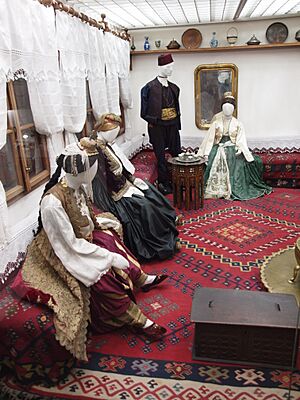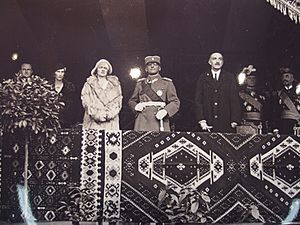Pirot carpet facts for kids
The Pirot rug (also called Pirot carpet or Pirot kilim) is a special type of flat, woven rug. It comes from Pirot, a town in southeastern Serbia. These rugs are often seen as a national symbol of Serbia. They are also an important part of Bulgarian folk heritage, as Pirot historically had many Bulgarian people.
Pirot rugs are made using a skill called tapestry weaving on a vertical loom. Weavers use wool and decorate the rugs with many different patterns. These patterns can be geometric shapes, plants, or even figures. The way Pirot rugs are made today has been influenced by Oriental and Bulgarian weaving styles.
Making Pirot rugs is so important that it's on the list of Intangible cultural heritage of Serbia. Pirot kilims are known for their many designs. There are about 122 different patterns and 96 types of these rugs! Because they are so unique, they were protected by a special geographical indication in 2002. This means only rugs made in Pirot can be called Pirot kilims.
These rugs are one of the most important traditional handicrafts in Serbia. In the past, especially before World War II, Pirot kilims were used by Serbian royalty. This tradition was brought back in 2011. Now, Pirot kilims are used again for important state ceremonies in Serbia.
Contents
A Look at Pirot Rugs

People have been weaving carpets in Pirot since the Middle Ages. One of the first times Pirot kilims were mentioned in writing was in 1565. Back then, they were used to cover boats on the Danube and Drava rivers.
Pirot used to be the most important place for rug-making in the whole Balkan region. This is because Pirot was on a major road that connected central Europe to a big city called Constantinople (now Istanbul). A cool thing about some Pirot rugs is that the weaver sometimes added their name and the year they made the rug.
Today, you can find many old Pirot kilims in museums and collections. They are in countries like Bosnia, Bulgaria, Croatia, Montenegro, Serbia, and Turkey. People love them for their beautiful colors and how the colors are put together. In the early 1800s, weavers started using aniline colourings instead of just plant dyes.
"The best product of the country is the Pirot carpet, worth about ten shillings a square metre. The designs are extremely pretty, and the rugs, without being so heavy as the Persian, or so ragged and scant in the web and woof as Caramanian, wear for ever. The manufacture of these is almost entirely confined to Pirot,"
The old Turkish name for Pirot was Şarköy. This is why Pirot rugs are sometimes called Şarköy-kilims. Sometimes, people mistakenly think these rugs come from a different place in Turkey called Şarköy. But the real Şarköy rugs have been made in the Western Balkan mountains since the 1600s. They were made in towns like Pirot, Berkowiza, Lom, Chiprovtsi, and Samokow. Later, they were also made in Knjaževac and Caribrod.
Groups That Keep the Tradition Alive

Several groups work to protect and promote the Pirot rug tradition:
- Association "Grlica"
- "Association of Preserving and Development of [the] Pirot Carpet" (started in 1995)
- "Pirot Carpet Cooperative" or "Pirot Carpet Zadruga" (started in 1902)
- "Damsko srce"
Where to See Pirot Rugs
You can find collections of Pirot rugs in different museums:
- In Serbia
- The Ethnographic Museum in Belgrade has a collection of these carpets.
- The Museum of Applied Art has a valuable collection of about 120 Pirot carpets. These rugs date from the late 1700s to the mid-1900s.
- Around the World
- The British Museum has two Pirot rugs in its collection (as of 2013).
Ornaments and Designs
Pirot kilims are famous for their many beautiful designs, called ornaments. There are about 122 different ornaments and 96 types of Pirot kilims. These designs are part of what makes them so special and unique. They were protected by a special geographical indication in 2002.
Gallery
Notable People Connected to Pirot Rugs
- Darinka Petković (1868–1932), who was the sister of a merchant named Kosta Petković.
Annotations








